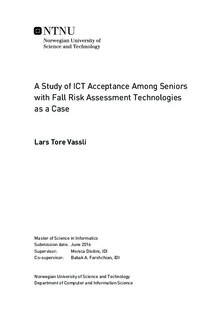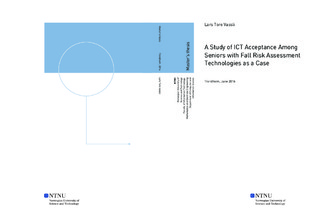| dc.description.abstract | The proportional number of elderly citizens is increasing in many parts of the world, and the need for healthcare ICT solutions that allow them to live independently in the community is equally increasing. It is important to tailor these solutions to this age group, in order to achieve a high degree of acceptance among the end users. To do this, we need to have a thorough understanding of how and why seniors use (or do not use) these technologies.
This master s thesis aimed to gather knowledge about how best to assess acceptance of an ICT system for community-dwelling seniors, and to evaluate this assessment method in a case involving a fall risk assessment system.
The first phase of the project consisted of a systematic literature review, aiming to find and present the findings from previous research relating to acceptance of health-related ICT among community-dwelling seniors. This involved analysing 11 review articles and 31 qualitative, primary research articles. The UTAUT2 acceptance model was used to structure the findings. The review found that some of the important factors for ICT acceptance among elderly include independence, safety and security, socialization, self-management of their health, getting help using the service, and tailored training. Some of the reported barriers to acceptance are lack of privacy, poor interaction design, obtrusiveness, and social stigma. These findings were then mapped to the constructs and moderating conditions in the UTAUT2 model, and a methodological tool for conducting theoretical evaluations of the acceptance of an ICT solution for elderly was created based on this mapping. The study also found that more research is needed in order to develop a specialized and operationalized acceptance model for ICT use among seniors. The mapping of the findings to UTAUT2 is a step in this direction, and suggests some improvements to this model.
Next, a set of concepts and a prototype of a front-end web solution was developed. This work was tied to a research project titled Adapt, regarding fall risk assessment for seniors. The acceptance of each of the concepts and the prototype were then theoretically evaluated using the evaluation tool created from the literature review. This demonstrated how the evaluation tool can be used in a real-world ICT project in order to assess which solution has the highest predicted acceptance. This could be a useful tool for healthcare service providers and others interested in finding the solution with highest acceptance when seniors should use a health-related ICT system. | |

